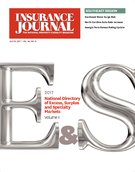North Carolina’s insurance regulator says he’s reached a deal with auto insurers for a premium increase of just over 2 percent instead of the nearly 14 percent average increase companies asked for in February.
Insurance Commissioner Mike Causey announced the signing of a settlement agreement with the North Carolina Rate Bureau in response to the Rate Bureau’s Feb. 1, 2017, request for a 13.8 percent increase in auto insurance rates. The North Carolina Department of Insurance agreed to a lower average increase of 2.2 percent, which the department said is a savings of more than $1 billion for North Carolina consumers over two years.
“It is unfortunate rates have to increase at all. But accidents from distracted driving are up, there are more people on the road because of lower gas prices, and higher medical and automobile repair costs are forcing auto rate increases all across the country,” Causey said.
The auto insurance rate change becomes effective for new and renewal policies beginning Oct. 1, 2017.
The Rate Bureau, an independent organization representing all auto insurance companies doing business in the state, has agreed not to submit an auto rate filing in 2018 so this rate change will be in effect for two years until Oct. 1, 2019.
Last year, traffic deaths jumped to the highest level in nearly a decade. According to the National Safety Council, the number of deadly accidents increased 7 percent in 2015 – and was estimated to increase 6 percent in 2016.
“Recent data shows North Carolina has the seventh lowest average auto premiums in the nation,” Causey said. “Our decision to settle was based on the increase in traffic deaths and other safety factors while also maintaining competition for insurance companies and options for consumers. We’ll continue to fight for lower, reasonable rates for consumers.”
NCRB’s filing was the first rate change proposed for private passenger auto by NCRB since 2009. NCRB said in a statement it is in response to a “dramatic increase in losses and the cost of those losses since 2014.”
“While the increase in losses has been a nationwide phenomenon, current data from the North Carolina Division of Motor Vehicles is particularly troubling,” NCRB said. “In 2015, the most recent year available, fatalities increased 8.1 percent from 2014, injuries increased 11.8 percent and reported crashes were up 11.1 percent.”
NCRB said the increase in losses is the result of a number of factors, but the most significant is the rise in the number of miles driven each year. In North Carolina, mileage driven in 2015 was up 13 percent from the average of the preceding five years. In addition, inflation in 2016 has increased vehicle repair costs by 2.4 percent and total medical care costs by 3.8 percent.
Two other factors more difficult to quantify, according to NCRB, are impaired drivers and distracted drivers.
The NCDMV estimates, for example, that in North Carolina, there were 7 percent more crashes in 2015 due to distracted driving and 13.2 percent more alcohol related crashes.
“All of these factors generate a need for the rate increase,” NCRB said.
Causey said in March the proposed auto insurance rate increase was not justified and scheduled a September hearing on the matter.
Had the case gone to hearing and NFRB had lost, by law it would have been allowed to implement its 13.8 percent rate increase while it appealed the rate order to the NC Court of Appeals and the NC Supreme Court.
It also would have been allowed to continue making annual rate filing for auto rate increases. NCDOI said that in that case, consumers may have had to pay unwarranted higher rates for months and possibly years until the case was resolved by the courts.
Topics Auto North Carolina
Was this article valuable?
Here are more articles you may enjoy.



 ‘Buffett Got it Wrong’ on California Fire Risk: PG&E CEO
‘Buffett Got it Wrong’ on California Fire Risk: PG&E CEO  Lloyd’s Insurers Don’t Expect Large Claims From Baltimore Bridge Collapse
Lloyd’s Insurers Don’t Expect Large Claims From Baltimore Bridge Collapse  London Firms Are Letting More Staff Work Entirely From Home
London Firms Are Letting More Staff Work Entirely From Home  Berkshire’s ‘Most Important’ Biz Drives Q1 Results; GEICO Still Behind on Tech
Berkshire’s ‘Most Important’ Biz Drives Q1 Results; GEICO Still Behind on Tech 


